Pizza in Melbourne: how to find the best Neapolitan pizzas
MELBURNIANS have been loving pizza ever since Salvatore Della Bruna opened the city’s first pizza shop, Toto’s, on Lygon Street. Here’s how the humble Italian staple has become one of the city’s biggest foodie obsessions.

Best of Melbourne
Don't miss out on the headlines from Best of Melbourne. Followed categories will be added to My News.
IF there is one food that is universally loved, it’s pizza.
From Naples to New York to Carlton, the saucy discs of flatbread deliciousness have sliced their way into the hearts of diners everywhere.
So significant is pizza’s contribution to the world that, in December 2017, “pizza napoletana” officially received UNESCO World Heritage status, cementing its position as a cultural food icon and ensuring the art of the Neapolitan Pizzaiuolo is preserved for generations to come.
The importance of pizza is not lost on Melburnians, who have been paying homage to the Italian staple since 1961, when Salvatore Della Bruna opened the city’s first pizza shop, Toto’s, on Lygon Street, introducing curious Victorians to a more westernised interpretation of a food he had grown up eating.
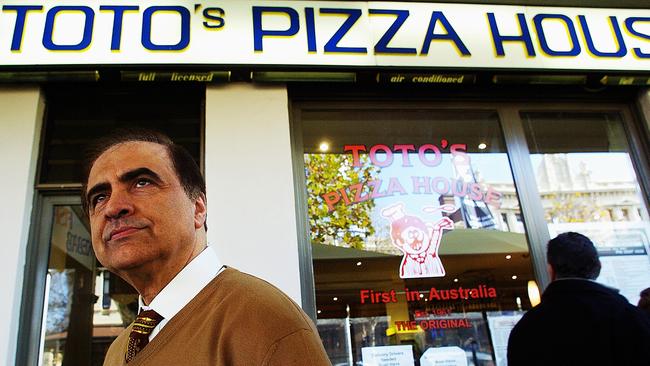
“Salvatore perfected what he thought would be good for Aussies,” says Sergio Mazloum, whose father, Sami, took over the business in 1983.
“He came from Napoli and had been working on pizzas there, but in Italy they make their pizzas differently; bases are very thin and they don’t put many toppings on, so he created something that he thought would appeal to people at the time.”
It was love at first bite.
MELBOURNE’S BEST PIZZA RESTAURANTS
Fast forward nearly 60 years and the rise and rise of Italian cuisine has seen pizza become of the most popular foods in the country, second only to “modern Australian”, according to 2017 survey by Eating Out in Australia.
But what, exactly, is pizza, how is it made and how can you tell if it’s authentic?
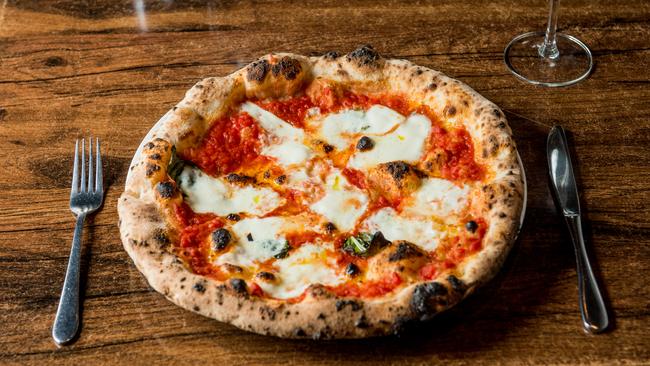
ORIGINS OF PIZZA
Legend has it the first pizza was created in 1889 in Naples, Italy, by Neapolitan pizza maker Raffaele Esposito. Raffaele was the proprietor of a popular local tavern and, as the story goes, when King Umberto I was passing through with his wife, Queen Margarita of Savoy, Esposito created a pizza in her honour, topped with tomato, mozzarella and basil to represent the colours of the Italian flag.
But, according to bona fide pizza master, Johnny Di Francesco, of 400 Gradi fame, pizza had existed for decades before then.
“A lot of people think it was the margherita,” Di Francesco says.
“But it wasn’t. The first pizza produced in Naples was the marinara. From what we know in Australia, marinara is seafood but, in Naples, the marinara is a simple pizza made with San Marzano tomatoes, oregano, garlic and extra-virgin olive oil.”
BEST ITALIAN RESTAURANTS IN MELBOURNE’S EASTERN SUBURBS
Pizza in Italy actually dates as far back as the late 1700s, Di Francesco explains, when it was used as a cheap and easy meal to feed hungry fisherman who would come back from sea after a night out on the water.
They didn’t have much money so they would go to the local tavern, where pizza makers would top thin-based flat breads with products that were cheap or close to spoiling — which was often a mix of tomato, oregano, olive oil and garlic.
That was the birth of what we have come to know — and love — as pizza.
“When the Queen of Savoy visited Naples, she wanted to eat what the Neapolitans considered to be traditional,” says Di Francesco, who was the first Australian to ever take out the title of World Pizza Champion at the Campionato Mondiale Della Pizza in Italy in 2014.
“That’s when Esposito made the pizza we know of today, which is topped with tomato, mozzarella and basil.”
BUT WHAT ABOUT FLAT BREADS?
The problem with producing such a prodigiously delectable alimentary essential is that everyone wants to take credit for it and, over the years, many countries have tried to claim they were the original pizza innovators.
“Neapolitans did make the first actual pizza, but if we talk about flat bread it was the Egyptians,” Di Francesco says.
“But being flatbread we can’t call it pizza.”
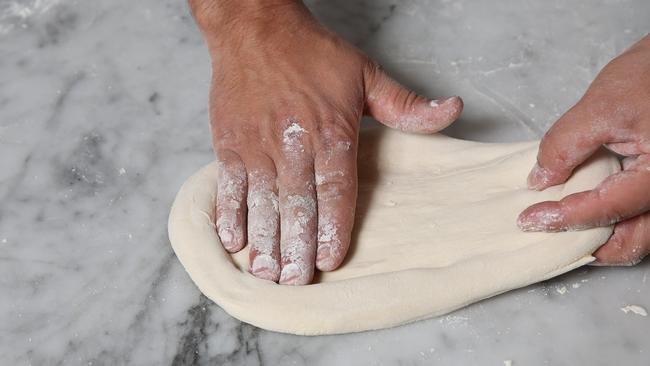
THE BASE
A good pizza is all about the base. This is what makes each pizza unique.
A good base is the foundation for a great-tasting pizza so, if the dough hasn’t been raised properly or left to mature for long enough, it’ll show in the final product.
With just four ingredients — flour, water, salt and fresh yeast — pizza dough is deceptively simple. But there is an art to achieving dough nirvana. And Di Francesco says it all comes down to flour.
25 OF MELBOURNE’S BEST ITALIAN CONNECTIONS
MELBOURNE A HEAVEN FOR INTERNATIONAL PIZZA TASTES
“For Neapolitan-style pizza, you need to use specific flour with a W rating of between 280 and 330 (such as 00 5 Stagioni Pizza Napoletana with a W280-330). This measures the protein content of the flour. Protein is really important because it has an effect on the elasticity of the dough — or how much is it going to stretch. The type of flour you use will depend on what style of pizza you are making and how long the dough needs to mature for. With Neapolitan-style pizzas, it needs to mature for at least 24 hours.”
This maturing process needs to happen over a longer period of time, at a lower temperature (2-3C) to ensure that the final product is lighter and easier to digest. The longer the maturation, the more time the yeast has had to feed on the sugars and complex carbohydrates, leaving you with stretchy dough that will give you a cooked base that is light, fluffy and beautifully fragrant.
Di Franceso also prefers using Italian flours as they are “experts in milling the right flour to make pizza”.
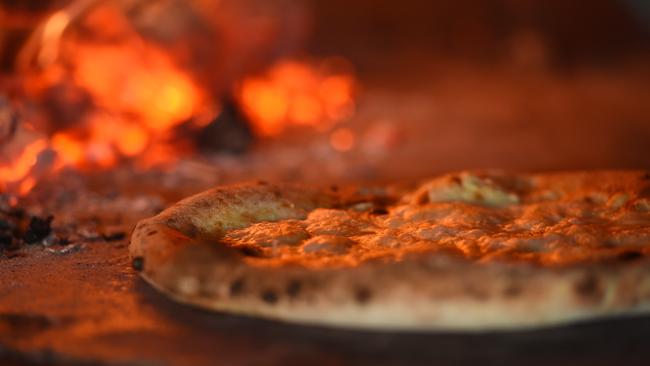
ROSSO OR BIANCO (RED OR WHITE)
Some pizza purists might say that red is traditional and, therefore, the most authentic sauce base. But Di Francesco says tradition isn’t everything.
“It just depends on what you feel like on the evening. I would eat a white-base pizza more during summer and a red base more during the colder months. During summer I love to use beautiful buffalo mozzarella, rocket and maybe prosciutto; in winter I’ll put hot salami — it all depends on your mood, really.”
WHAT ABOUT TOPPINGS?
How many toppings a pizza should have on it has been the subject of much debate. While five is the magic number for Di Francesco, he says the distribution of flavours is more important than the number of them.
“It doesn’t matter how many topping you put on there, but the flavours need to be evenly spread so the pizza doesn’t become a birthday cake,” he says.
“If you’re making a capriciosa for example, there needs to be an equal balance on each slice but you don’t want to use a tonne of ham, mushroom, olives and artichokes or it’s too much.
“Less is more.”
PIZZA ETIQUETTE
To fork or not to fork, that is the question. And in the case of proper pizza etiquette, the resounding consensus is not to fork. While you probably won’t get arrested for forking in public, you’re unlikely to ever see a local using cutlery.
“I worked in a few pizzerias in Naples and when we would see somebody cut pizzas with a knife and fork, we knew they weren’t locals,” Di Francesco says. “In Italy, everyone uses their hands.”
“The knife and fork is to cut through your pizza but then you’re meant to pick it and eat it you’re your hands.”
But wood-fired pizza is too messy to eat with your hands, you say?
“There is a misunderstanding about Neapolitan pizza. It’s not meant to be crispy. It is not the kind of pizza you can pick up a slice and all the toppings will stay in place without sliding off. How you eat it is by folding the two ends of the crust together, then folding the narrow end of the triangle back towards the crust. I guarantee you if you eat it this way it will taste different.”
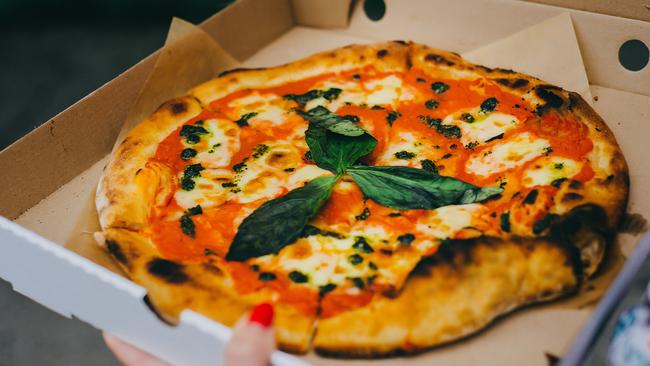
WHAT TO LOOK FOR IN AN AUTHENTIC PIZZA
If you’re wanting to judge a pizza on its authenticity or quality, always opt for a margherita or a marinara, Di Francesco says, because each only has four ingredients: tomato, oregano, garlic and extra-virgin olive oil for the marinara and tomato, mozzarella, basil and olive oil for the margherita.
“It might seem as though they are the simplest pizzas but, in fact, they’re the hardest to produce because you can’t hide behind four ingredients,” he explains.
“If your base isn’t made correctly or if you haven’t made a really beautiful pizza dough it will come out.”
If a pizza has more toppings, it can disguise if the dough hasn’t been made correctly because all you get is the flavour of the ingredients so you can’t always see if the dough has matured or risen correctly.
ITALIAN SNACK PACK: THE NEXT MELBOURNE FOOD CRAZE?
“I can tell straight away whether it’s had the right maturity and rising time,” Di Fracesco says. “I look at the bottom to make sure it hasn’t been burnt. I also smell my pizza — that indicates if the products on top are good quality — especially the olive oil. It’s not hard to distinguish good quality toppings these days.”
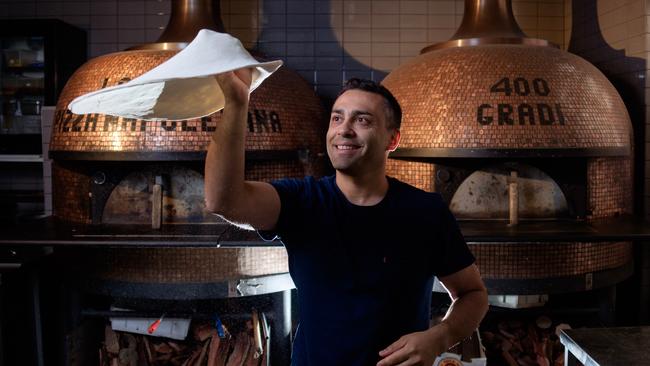
FAST FIVE WITH JOHNNY DI FRANCESCO
FIRST PIZZA YOU EVER ATE?
The first pizza I ever ate would have probably been a homemade pizza by my grandmother when I was a kid, but the first pizza I ate at a restaurant was at a place called Tiffany’s on Sydney Road in Brunswick, probably 34-35 years ago.”
WHO IS THE BETTER COOK NOW, YOU OR YOUR NONNA?
Definitely my nonna; at 93 she is still the best cook I know.
FAVOURITE WINE TO PAIR WITH PIZZA?
I don’t mind a glass of prosecco with margherita. It might sound strange but the bubbles make the tomato taste really beautiful.
BEST PIZZA ADVICE YOU’VE EVER RECEIVED?
The best pizza is the pizza you like eating. Who am I to dictate what style of pizza you like the best?
CAREER HIGHLIGHT?
I have been making pizza for 28 years and being crowned the World Pizza Championone has definitely been one of the biggest highlights in my career. We go to work every day and do what we love — to be recognised for that passion is just another level of achievement; not just for me, personally, but for all my staff and also for the whole of Australia. People around the world know us for producing pizza — to be noticed for it and for people to recognise us and reference us — that’s just amazing.”


